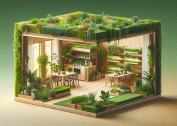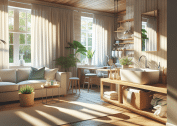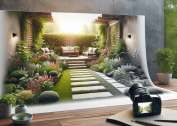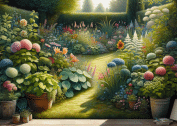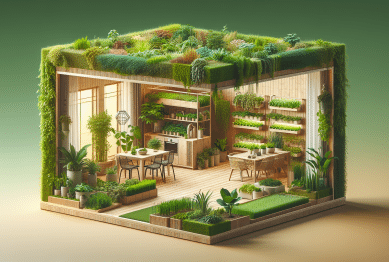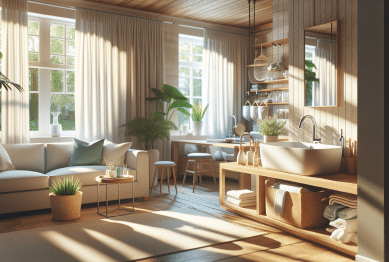Discover inspiring outdoor living ideas that turn even the tiniest backyard or balcony into a relaxing retreat. Learn clever ways to maximize space, introduce greenery, and elevate comfort, no matter the size of your home. Get practical tips for easy, beautiful, functional results for your outdoor area.
Why Outdoor Spaces Matter for Well-Being
Spending time outdoors has profound benefits for well-being and mental health, no matter the size of your available space. Many people report feeling calmer and happier after enjoying time on a small patio or balcony, surrounded by greenery or simply fresh air. Creating an inviting outdoor living space boosts quality of life, encourages relaxation, and promotes a sense of connection with nature. Studies confirm that even limited outdoor time can de-stress the mind and invigorate creativity, making the investment in outdoor comfort truly worthwhile (https://www.ncbi.nlm.nih.gov/pmc/articles/PMC5663018/).
Today’s lifestyles often limit access to spacious yards, but compact outdoor spaces are increasingly recognized as valuable extensions of the home. Whether it’s a cozy apartment balcony, a townhouse deck, or a narrow side garden, small outdoor areas present unique opportunities for customization and enjoyment. The trend towards maximizing every square foot, both indoors and outside, leads to creative design solutions that accommodate gardening, lounging, and even dining within modest footprints. With thoughtful planning, any outdoor area can become a functional sanctuary.
Incorporating comfortable seating, weather-friendly furnishings, and greenery can have surprising effects on daily routines. A couple of potted plants, a hammock chair, or ambient lanterns instantly transform unused corners into cheerful retreats. These outdoor nooks provide places for reading, meditating, sharing meals, or entertaining neighbors. Over time, investing in such spaces may foster healthier habits and encourage more time away from screens, ultimately supporting holistic well-being for household members of all ages (https://www.tandfonline.com/doi/full/10.1080/09603123.2021.1964801).
Smart Space-Saving Furniture and Features
Furnishing small outdoor spaces requires creativity and a focus on multi-use solutions. Folding chairs, nesting tables, and stackable stools offer flexibility, allowing an area to adapt for solo relaxation or group gatherings. Wall-mounted tables or benches save floor space and give the illusion of a larger footprint. Some popular features include built-in planters, corner benches with hidden storage, or slim-profile shelves perfect for herbs or decor. Smart furniture choices ensure that no square inch is wasted.
Many homeowners are incorporating portable fire pits or collapsible umbrellas to maximize both comfort and function. These elements can be stowed away to open up space when not needed. For apartments or condos, consider railing-mounted tables and vertical drink holders to keep surfaces uncluttered. Modular outdoor rugs define separate zones within limited areas and help tie the design together. Compact water features or mini fountains introduce soothing sounds without requiring major installations (https://www.gardenia.net/guide/small-garden-design-ideas).
Lighting can also optimize your use of small spaces. Solar-powered fairy lights or wall sconces provide gentle illumination well into the evening, extending outdoor enjoyment after sunset. Lightweight lanterns and battery-operated lamps supplement overhead lighting and make rearranging easy as needs change. By choosing versatile, weather-resistant furnishings and accessories, it becomes easy to redesign or refresh your outdoor area throughout the year, keeping it engaging and personalized.
Introducing Greenery with Minimal Fuss
Even on the smallest balcony, greenery makes a dramatic difference in ambiance and comfort. Container gardening is one of the easiest ways to add nature to compact spaces. Pots come in all sizes and shapes, allowing for stacking, hanging, or lining up along rails and shelves. Choose low-maintenance plants like succulents, ferns, or dwarf evergreens if upkeep is limited. Edible options—herbs, tomatoes, or lettuce—thrive in containers and provide fresh ingredients within arm’s reach (https://extension.psu.edu/10-small-space-gardening-tips).
Vertical gardens are a favorite strategy for maximizing greenery in urban environments. Wall-mounted planters, living walls, and trellises allow vining or cascading plants to flourish without encroaching on ground space. Some systems use modular panels or pockets, making them easy to install and move. Trailing ivies, pothos, and flowering annuals can transform a bare fence or wall into a lush, eye-catching backdrop. Vertical solutions also create a sense of privacy and help soften hard architectural lines.
For renters or those without garden beds, raised planters or window boxes offer flexibility and visual interest. Grouping pots by color, height, or bloom time makes displays feel intentional and cohesive. Even a few well-placed pieces of greenery can attract pollinators, provide screening, and moderate the microclimate, ensuring time spent outdoors is more refreshing. With the right plant choices, it’s easy to create an oasis in the heart of the city or a cozy cottage vibe in any neighborhood.
Making Outdoor Living Comfortable Year-Round
One challenge of outdoor living is adapting the space for changing seasons. Weatherproof materials, such as powder-coated metals, resin wicker, and outdoor-grade fabrics, withstand rain, sun, and temperature swings. Cushions and pillows designed for outdoor use resist fading and mildew, extending the life of your setup. Removable covers or storage benches help keep textiles fresh when not in use. A small awning, retractable shade sail, or portable canopy increases both comfort and privacy for predictable enjoyment.
On cooler nights, add warmth with outdoor-safe heaters or fire pits. Compact propane or electric models fit well on balconies and patios. Layering throws, fuzzy seat pads, and weatherproof rugs further enhances coziness. In moderate climates, removable windbreak screens or clear vinyl curtains can convert an open area into a more sheltered retreat, allowing for longer use through shoulder seasons. Smart planning can ensure the outdoor area feels welcoming even during unexpected weather changes (https://www.epa.gov/heatislands/using-trees-and-vegetation-reduce-heat-islands).
Summer brings its own considerations, especially with sun exposure and pests. Consider using UV-blocking shade cloths and installing unobtrusive mosquito nets or citronella pots to keep gatherings bug-free. Airy fabrics, reflective surfaces, and strategic plantings keep spaces cool, while self-watering planters assist with hydration during peak heat. With just a few tweaks each season, outdoor living areas remain inviting and usable all year round, no matter the weather.
Personal Touches and Creative Decor Ideas
The most memorable outdoor spaces reflect the personality and preferences of their inhabitants. Use outdoor-safe art, whimsical lanterns, or patterned cushions to add interest and vibrancy. Recycled containers, vintage watering cans, or mosaic tile tables can serve as both focal points and conversation starters. Small water features or wind chimes introduce soothing sensory experiences, balancing visual decor with sound and motion.
DIY projects are popular for those seeking unique solutions or wanting to stay within a budget. Pallet sofas or crate planters are not only sustainable, but also easy to build for homeowners and renters alike. Painted pots, stenciled outdoor rugs, or homemade bird feeders give the space a handcrafted, welcoming feel. These small investments provide lasting satisfaction and encourage people to spend more time enjoying their outdoor havens.
Lighting’s role in decor is often underestimated. Integrated solar lights, string globe lights, or colored LED spotlights can accentuate key features, create ambience, and ensure safe movement after dark. Combining lighting with playful accessories like outdoor pillows or a mini bar cart brings a festive, resort-inspired vibe to even the simplest setup. The beauty of these personal flourishes is their flexibility—change them out as seasons, trends, or tastes evolve to keep inspiration flowing.
Maximizing Outdoor Living on a Budget
Transforming a small outdoor space doesn’t require a substantial investment. Many high-impact upgrades have low costs, especially when focusing on DIY solutions or upcycling found materials. Garage sales, thrift shops, and online marketplaces are reliable sources of affordable outdoor furniture or decor. Repurposing existing indoor items for outside use can reduce costs dramatically. The secret is prioritizing comfort and flexibility over matching sets or trends.
Grow-your-own options also offer cost savings and ongoing benefits. Starting herbs, lettuce, or cherry tomatoes from seed can provide fresh food for months at a fraction of grocery prices. Community gardens sometimes share resources, plants, or tools for free, making gardening more accessible to residents with limited yard access. Improving soil with compost—often available free from municipal programs—supports healthier, more resilient plants without continual fertilizer purchases.
Finally, it’s wise to shop end-of-season sales for weather-resistant furniture or plan ahead for next year’s improvements. Investing in timeless, durable materials is often more economical in the long run. Even with a modest budget, a little creativity and strategic planning enable anyone to make the most of their small outdoor living spaces. Experiment, get inspired by others’ ideas, and enjoy the process as much as the result (https://www.almanac.com/content/urban-gardening-growing-cities).
References
1. Gorman, C. (2017). The mental health benefits of getting outside. Retrieved from https://www.ncbi.nlm.nih.gov/pmc/articles/PMC5663018/
2. Rice, W. L., Pan, B., & Chen, K. T. (2021). These walks can be a game-changer for health and happiness. Retrieved from https://www.tandfonline.com/doi/full/10.1080/09603123.2021.1964801
3. Gardenia.net Editors. (2024). Small garden design ideas. Retrieved from https://www.gardenia.net/guide/small-garden-design-ideas
4. Penn State Extension. (2021). 10 small space gardening tips. Retrieved from https://extension.psu.edu/10-small-space-gardening-tips
5. United States Environmental Protection Agency. (2023). Using trees and vegetation to reduce heat islands. Retrieved from https://www.epa.gov/heatislands/using-trees-and-vegetation-reduce-heat-islands
6. The Old Farmer’s Almanac. (2022). Urban gardening: Growing in cities. Retrieved from https://www.almanac.com/content/urban-gardening-growing-cities

